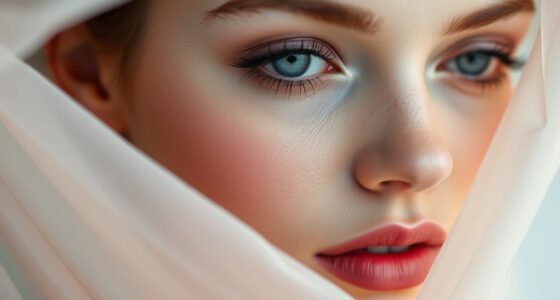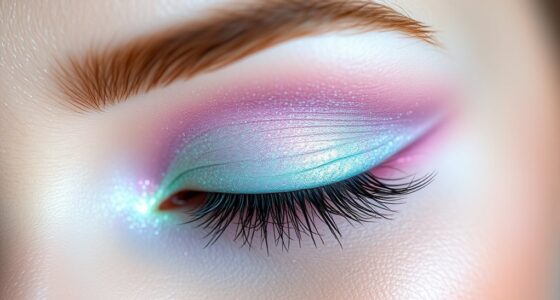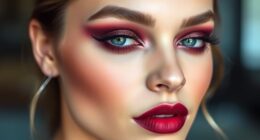To create a multi-dimensional blush look, start with a cream blush that complements your skin tone for a natural base. Then, gently set it with a matching powder blush to boost longevity and build depth. Use soft, blending brushes to seamlessly merge the layers, avoiding harsh lines. Experiment with different shades and techniques to customize your glow. Keep exploring these tips for a flawless, radiant finish that lasts all day, revealing more about perfect layering techniques.
Key Takeaways
- Select complementary cream and powder blush shades based on skin tone and undertone for a harmonious, natural glow.
- Apply cream blush first to create a natural base, then layer powder for added dimension and longevity.
- Use soft, fluffy brushes to blend edges seamlessly between cream and powder layers.
- Build color gradually by layering and adjusting intensity to achieve desired depth and vibrancy.
- Avoid mismatched shades and patchiness by matching formulas and applying product gradually for a seamless finish.
Choosing the Right Cream and Powder Blush Shades
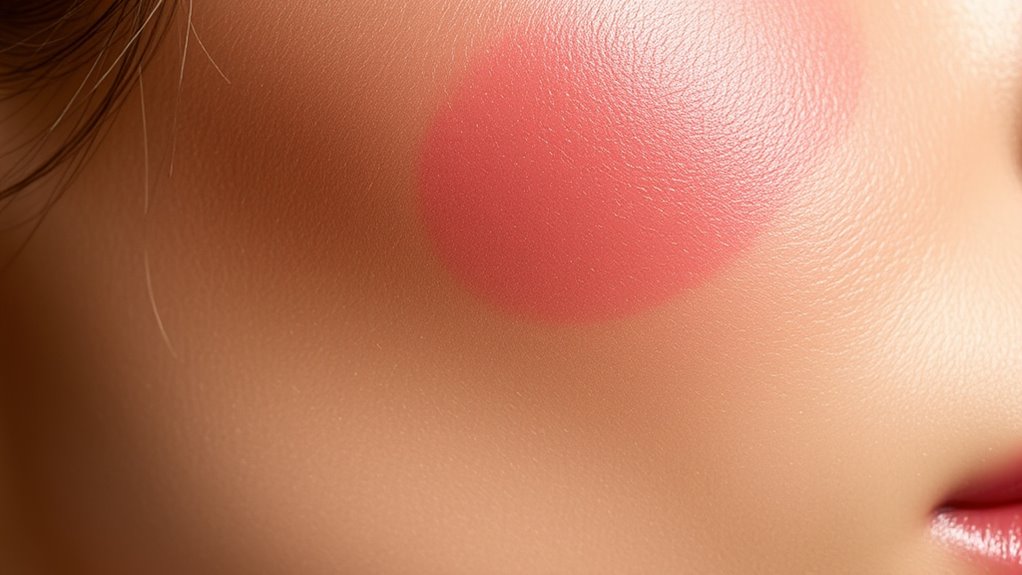
When selecting cream and powder blush shades, it’s vital to take into account your skin tone and undertone. Proper shade matching ensures your blush enhances your natural complexion, creating a harmonious look. Additionally, understanding blush application techniques can help you achieve a more natural and flattering finish. Consider undertone considerations—whether cool, warm, or neutral—as they influence which shades complement your skin best. For cool undertones, opt for rosy or berry hues; for warm undertones, choose peachy or apricot shades. Neutral undertones give you more flexibility, allowing you to experiment with a variety of colors. Being aware of skin undertones can further refine your shade choices and help you create a balanced, radiant appearance. By focusing on shade matching and undertone considerations, you’ll find blush tones that amplify your features and blend seamlessly with your skin.
Preparing Your Skin for Layering
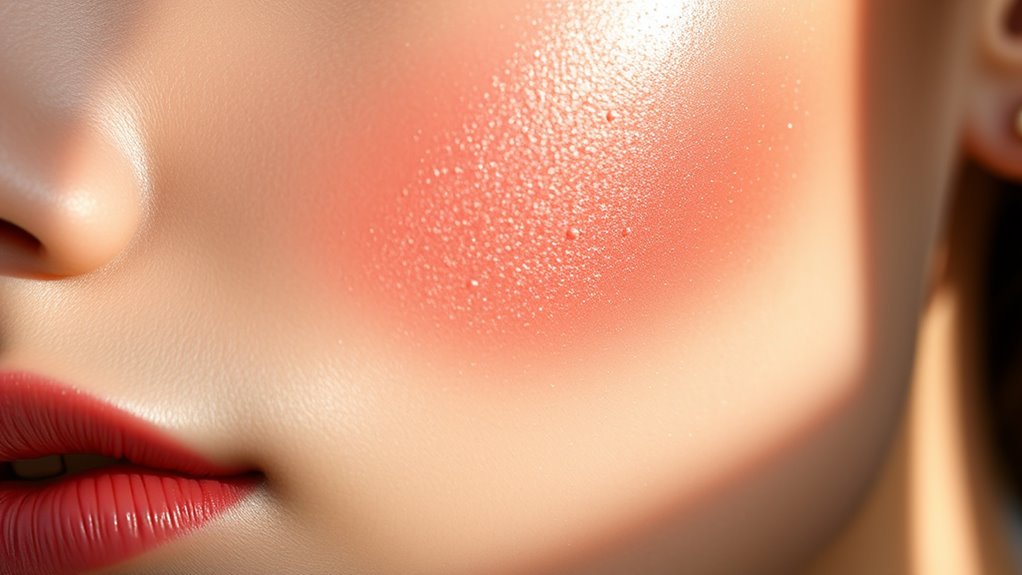
To guarantee your blush layers smoothly and lasts longer, preparing your skin properly is essential. Start with a consistent skincare routine that cleanses and moisturizes your face, creating a clean canvas. Incorporating gentle exfoliation can remove dead skin cells, ensuring an even application. Then, focus on primer selection—choose a primer suited to your skin type and concerns. A pore-filling primer helps smooth your skin’s surface, while a hydrating primer adds a dewy glow. Applying primer evenly sets the stage for flawless blush application and prevents makeup from slipping or caking. Let the primer absorb fully before adding any color. Skin preparation is a crucial step that can significantly impact the overall look and durability of your makeup. Proper skin prep not only enhances blush application but also supports the performance of self watering plant pots by maintaining a healthy environment for your plants.
Applying Cream Blush for a Natural Base

Applying cream blush for a natural base starts with selecting a shade that complements your skin tone and desired look. Use a clean blush brush to gently blend the product onto the apples of your cheeks, working upward toward the temples. For a seamless finish, choose a hue that offers subtle color contrast—slightly deeper than your natural flush but not overpowering.
| Skin Tone | Recommended Cream Blush Shade |
|---|---|
| Fair | Soft pinks, peachy shades |
| Medium | Coral, rosy beige |
| Olive | Warm apricots, terracotta |
| Deep | Rich berry, brick tones |
| Neutral | Mauve, dusty rose |
This approach creates a fresh, natural glow, setting the perfect base for layering powder blush later.
Setting With Powder Blush for Longevity

Setting your blush with powder is essential for ensuring it stays in place throughout the day. To do this effectively:
- Pick a blush brush that’s soft and blends easily for a smooth application.
- Lightly dip your brush into the powder, tapping off excess to avoid over-application.
- Use color coordination by choosing a powder blush that complements your cream blush shade.
- Gently sweep the powder over your cream blush, focusing on areas where the color needs extra staying power.
- Incorporating proper layering techniques can further enhance your blush’s durability and natural appearance. Proper layering not only improves longevity but also helps achieve a more seamless finish for a natural look. Utilizing layering methods that combine different textures and shades can also add depth and dimension to your blush application. Paying attention to product application techniques ensures a more polished and long-lasting result. Being mindful of product consistency ensures that each layer adheres well and blends seamlessly with the previous one.
This layering technique creates a seamless finish and prolongs your blush’s longevity.
Techniques for Seamless Blending

Seamless blending is essential for achieving a natural, polished blush look. To do this, choose brush tools with soft, flexible brush textures that allow for smooth, even application. Starting with a light hand helps prevent over-application and maintains a natural finish. Begin by lightly loading your brush with product, then gently buff it onto your skin using circular motions. Focus on blending the edges where the cream and powder meet, ensuring there are no harsh lines. Use a clean brush with similar texture to soften any streaks or excess pigment. Keep your movements light and gradual, building color gradually rather than applying too much at once. Proper technique and the right brush tools help merge different textures seamlessly, creating a cohesive, dimensional glow. Incorporating knowledge of texture blending can enhance the seamless transition between cream and powder finishes. Applying layering techniques thoughtfully can further improve the overall harmony of your blush application. Patience and gentle strokes are key to flawless blending.
Tips for Building Dimension With Layering

To build dimension with layering, focus on blending your colors seamlessly so your blush looks natural. Incorporate color theory principles to select shades that complement each other for a harmonious look. Vary the application intensity—apply lighter shades for a soft glow and deeper tones for contouring. This balance creates a multi-dimensional, radiant finish that enhances your features effortlessly. Additionally, using the right tools, such as fluffy brushes, can help achieve a more blended appearance for a polished look. Understanding vehicle tuning options can also inspire creative ways to personalize your makeup routine, much like customizing a vehicle for optimal performance. Taking time to properly change gears on your makeup application can help you achieve smoother transitions between shades and a more professional finish. Embracing authentic self-expression through makeup can further elevate your unique style and confidence.
Blend Colors Seamlessly
Layering colors effectively is essential for creating a natural, dimensional blush look. To blend colors seamlessly, pay attention to brush textures, which influence how smoothly the product applies. Use soft, fluffy brushes for gentle progression, avoiding harsh lines. Additionally, selecting the appropriate headphone jack ensures compatibility with your device, making the application process smoother. Incorporating color theory principles can help you select harmonious shades that enhance your overall look. Apply color according to color theory principles—complementary shades enhance contrast, while analogous hues create harmony. Here are four tips to help you blend seamlessly:
- Start with a light base, gradually building intensity.
- Use circular motions to diffuse edges smoothly.
- Layer from cream to powder for depth and dimension.
- Blend with a clean brush between layers to merge colors effortlessly.
- Embracing the creative spark can inspire more innovative makeup techniques and personalized styles. Additionally, understanding product formulation can assist in achieving a more natural blend and longer-lasting finish. Recognizing the importance of security vulnerabilities in new beauty tools and products can also help in selecting safe and reliable options for your routine.
Vary Application Intensity
Varying the application intensity of blush is key to creating a multidimensional and natural look. Adjusting your application intensity allows you to control the color saturation, making your cheeks appear more subtle or bold as desired. To enhance the overall effect, consider incorporating color accuracy such as linen or soft fabrics that mimic the cozy textiles found in farmhouse bedrooms. For a softer effect, use a light hand with cream blush and blend well, building up gradually. If you want more vibrancy, layer powder blush over the cream, increasing the color saturation step by step. This technique helps you customize your look for different occasions or moods.
Common Mistakes to Avoid When Layering

One common mistake people make when layering blush is choosing shades that clash or don’t complement each other, which can result in a disjointed or unnatural look. To avoid this, focus on shade coordination and product compatibility.
- Ignoring undertones: Pick blush shades that match your skin’s undertone to ensure harmony between cream and powder layers.
- Overlapping textures: Use compatible formulas—like cream over cream or powder over powder—to prevent patchiness.
- Choosing unrelated colors: Stick to a cohesive color palette; combining shades that don’t blend well can look harsh.
- Applying too much product at once: Build your blush gradually for a natural, seamless finish without overwhelming your look.
Paying attention to these details helps you create a balanced, harmonious glow without mistakes.
Customizing Your Glow With Different Blush Combinations
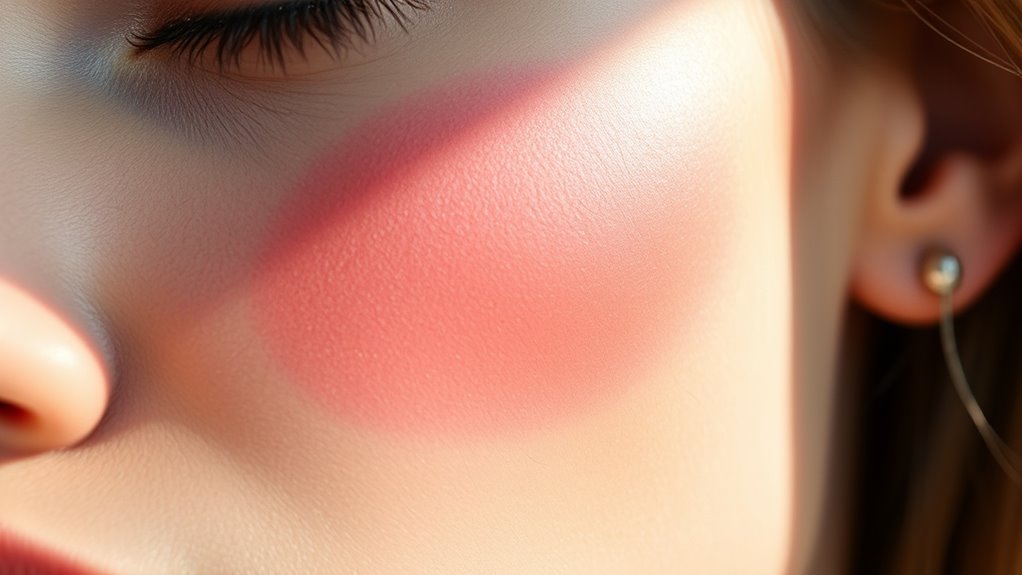
You can create a more dynamic glow by layering different blush shades to add depth.
Don’t be afraid to mix colors creatively to find unique combinations that suit your skin tone. Experimenting with these techniques helps you personalize your look and achieve a radiant finish.
Layering for Depth
Layering different blush shades creates a more dynamic, multidimensional glow that naturally enhances your features. To achieve a flawless finish, focus on color harmony by selecting shades that complement each other. Here are four ways to layer for depth:
- Start with a sheer, matte base to set the tone.
- Apply a slightly deeper hue on the apples of your cheeks for dimension.
- Dust a soft, shimmery shade slightly above for subtle glow.
- Blend seamlessly to unify the layers, ensuring a natural, radiant look.
This technique adds depth without overpowering, making your blush look more realistic and vibrant.
Thoughtful layering emphasizes your features, giving you a polished, multidimensional glow that feels effortless.
Mixing Shades Creatively
Mixing shades creatively allows you to customize your glow and express your unique style. By blending different blush tones, you can enhance your features and create striking color contrasts. For example, pairing a soft peach with a vibrant coral adds warmth and dimension, while combining a cool pink with a deep berry creates an eye-catching contrast. Experimenting with blush combinations enables you to tailor your look for any occasion. Here’s a quick visual guide:
| Blush Tone 1 | Blush Tone 2 | Result |
|---|---|---|
| Soft Peach | Bright Coral | Warm, lively glow |
| Cool Pink | Deep Berry | Bold, dramatic contrast |
| Nude Beige | Rosy Pink | Subtle, natural flush |
Feel free to mix and match to find your signature look with dynamic color contrasts.
Frequently Asked Questions
Can I Use Cream and Powder Blush on Oily Skin?
Yes, you can use cream and powder blush on oily skin. Start with a lightweight cream blush to add a natural flush, then set it with a matte powder blush to control shine and increase longevity.
Make sure to use a mattifying primer beforehand and apply the powder blush with a fluffy brush. This layering technique helps your blush stay put and prevents excess oil from making it look greasy.
How Do I Prevent My Blush From Looking Cakey?
Think of your blush as a delicate watercolor painting—too much and it drips into unwanted areas. To prevent cakeyness, choose a blush with a smooth texture and apply it with a light hand.
Use your fingers or a fluffy brush, blending seamlessly along your cheekbones. Build up gradually, and always set with a translucent powder if needed.
This technique keeps your blush fresh, natural, and beautifully blended.
What Tools Work Best for Blending Layered Blush?
To blend layered blush seamlessly, use soft, fluffy brushes with gentle circular motions. Focusing on brush techniques that diffuse the product naturally will help achieve a smooth finish.
Blending sponges also work well—dampen one slightly and tap gently over your cheeks to meld cream and powder layers. Avoid harsh strokes, and build up color gradually.
This approach guarantees a smooth, unified finish, giving you a radiant, natural glow without any cakiness.
Should I Apply Highlighter Before or After Blush Layering?
Think of your face as a canvas; highlight placement is the shining star, so apply highlighter after blush layering to let your features glow naturally.
Using layering techniques, start with blush for depth, then add highlighter to accentuate cheekbones and brow bones. This order guarantees your glow looks seamless and radiant, like a sunrise.
Applying highlighter last creates a luminous finish that draws attention to your best features effortlessly.
How Do I Choose Blush Shades for Different Skin Undertones?
You should choose blush shades based on your undertone matching and desired shade contrast. For warm undertones, opt for peachy or coral hues that enhance your natural glow.
If you have cool undertones, go for pinks or mauves to complement your skin. For neutral undertones, experiment with both warm and cool shades.
Always consider the contrast—lighter shades create a subtle look, while deeper shades add drama.
Conclusion
By mastering the art of layering cream and powder blush, you can create a natural, multidimensional glow that enhances your features. For example, imagine customizing a soft, luminous look for a daytime outing by starting with a cream blush and setting it with a light dusting of powder. With practice, you’ll confidently blend shades and build depth, ensuring your blush looks seamless and radiant—perfect for any occasion.




